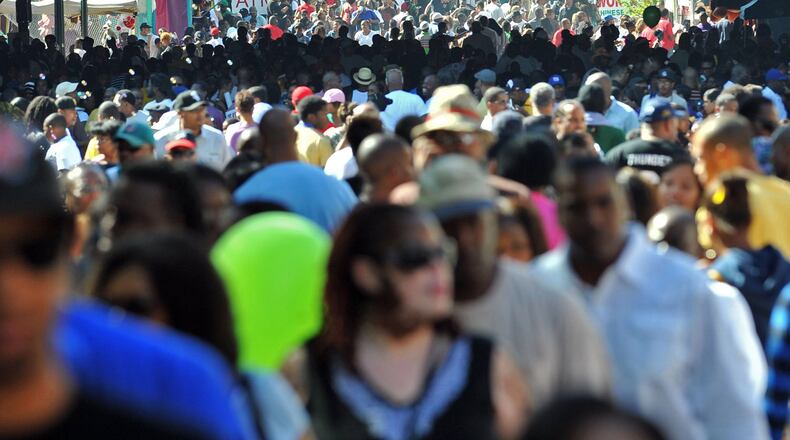It should be an easy question: How many white and how many black residents have lived in Atlanta over the years, since before the Civil War? The answer is as simple as looking up the U.S. Census site.
All we have to do first is define "black" and "Atlanta." Still sound easy?
It's not, of course. The census has always been vexed by definitions of race and metropolitan-area boundaries. And unlike the rest of us who constantly squabble over ITP/OTP signifiers or wrestle with personal identity, the census is charged with putting a very precise number (no fractions!) on how many people of a certain kind live where.
Who is black?
Reading census reports before 1870 is sobering. In those years before the Civil War, the census provided separate columns for "Free Colored" and "Slave." For some of those reports, slaves could be found in separate "slave schedules." Most historians combine the "Free Colored" and "Slave" columns for a count of black residents for those years. For example, 18 "free coloreds" and 493 slaves lived in Atlanta in 1850, for a total of 511 blacks.
The "Free Colored" and "Slave" categories also broke down into "Black" and "Mulatto." Mulatto (further broken down to "Quadroon" and "Octoroon") would continue to be a sub-category until 1930, when census policy shifted toward more rigid racial definitions. Whites, too, were being sub-categorized during this time along ethnic (not racial) lines, as the census attempted to define who was native and who was fresh off the boat from Europe. "Indians" and citizens of Asian descent were increasingly represented too and sub-categorized.
"Negro" replaced "Colored" in 1890 and remained the preferred term through 1970, after which "Black" and "African-American" began to duel it out. The terms may have changed over the years, but the census reports did not sub-categorize this racial group between 1930 and 1990.
Starting in 2000, the census showed more flexibility by inviting Americans to check more than one box if appropriate. On recent reports, you'll now find "Black or African American" reported under "One race," and that "Two or more races" has its own column. For our chart, we decided to go with the "One race/Black or African American" number.
None of this answers "Who is Black?" Then again, would you want it to?
The limits of city limits
What happens inside Atlanta's city boundaries is only part of metro Atlanta's story, and this was true long before there was any Perimeter to be inside or outside of. The census has made a number of heroic attempts over the decades to define the region's true scope, by using larger regional areas called metro statistical areas (MSAs).
Starting with the 1950 census, you can follow the progress of Atlanta's MSA, but there's a catch--the definition of the MSA kept changing, from five counties in 1950 to a whopping 29 today. For historical comparison purposes, MSAs are problematic.
Instead, we've chosen to look at Fulton County's growth since 1850. It's no real substitute for the whole of metro Atlanta, but its population figures are easier to track back to 1850 and it still serves as a good measure against Atlanta's growth during that historical stretch.
Reading between the lines
There are plenty of stories to tell on these charts if you know where to look. Here are just a few:
Bigger city, more whites, Part 1: From 1900-1930, Atlanta's growth accelerated, as did whites' numbers. Atlanta did expand into white neighborhoods like Ansley Park and Druid Hills during this time, but that can't fully explain why the black population didn't keep pace. What's going on?
Joseph O. Jewell, a sociology professor at Texas A&M who has written on the growth of Atlanta's black middle class, may know the answer: "You can attribute this to the earliest part of the Great Migration. Blacks had been leaving the Southern U.S. since the 1890s, but the movement picked up significantly in the early 20th century with the passage of Jim Crow laws and the uptick in racial violence."
Bigger city, more whites, Part 2: What in the world accounts for that huge rise after 1950? That would be the 1952 Plan for Improvement. After several failed attempts, Atlanta was finally allowed to triple its size overnight, instantly adding 100,000 new residents. It's a complicated story, but it's clear that race was a primary motivator for the expansion--the move incorporated a slew of white neighborhoods, giving whites a new cushion in their attempts to keep a voting majority.
Despite this fact, the plan was supported by many local black leaders and was endorsed by the Negro Voters League. According to Kevin Kruse in his book "White Flight", for many black Atlantans, "the plan seemed to strengthen their political position. The whites annexed by the city were, after all, much like their current partners in the coalition. Politically, they would side with them in future elections."
White flight (among other things): Whites moved out of Atlanta in huge numbers from 1960-80 as blacks moved in. It's tempting to call this merely "white flight" and be done with it. But use plenty of caution. As Larry Keating, an emeritus professor at Georgia Tech and author of "Atlanta: Race, Class and Urban Expansion," explains, "White flight was real, but so also was white suburbanization. White folks were choosing NOT to move into the city. Some of this reflects the fact that the city was becoming more 'built-out,' but the suburbs were increasing substantially."
In other words, the suburbs had their own good thing going on economically, attracting new residents who wanted to live closer to those opportunities. These economic opportunities would act as a "pull" for many white Atlantans at the same time that racial anxieties created a "push."
Further economic trends were in play as well. Here's Joseph O. Jewell again: "Atlanta's pattern of growth (shaped by its history of segregation) meant that economic growth and employment opportunities may happen in the metropolitan area, but not in the city itself, leaving blacks confined to Atlanta with fewer economic opportunities and whites with the ability to travel to them."
Recent gentrification: The most recent decades show an uptick in whites moving into Atlanta, with blacks starting to move out. Today's Atlantans are familiar with seeing whites move into formerly black intown neighborhoods, but it may surprise some to see the city's black population in decline.
Jewell attributes the black population drop to a combination of things--a "push" of declining neighborhoods, rising home prices, slower job growth and aging homeowners giving up their homes; and a suburban "pull" that acts much as it did on whites in earlier decades. "Over the last 10 or 15 years, Atlanta has seen an influx of younger, highly educated black professionals who can afford to take advantage of the job opportunities and larger suburban homes with better schools," he says.
Atlantans continue to write this story every day. And as befits an international city, more voices from more ethnic groups join the conversation, even as we tend to speak from our separate enclaves. For a beautifully stark view of metro Atlanta’s current state of racial segregation, look no further than the map below, created by Dustin Cable of the Weldon Cooper Center for Public Service.
About the Author
Keep Reading
The Latest
Featured





